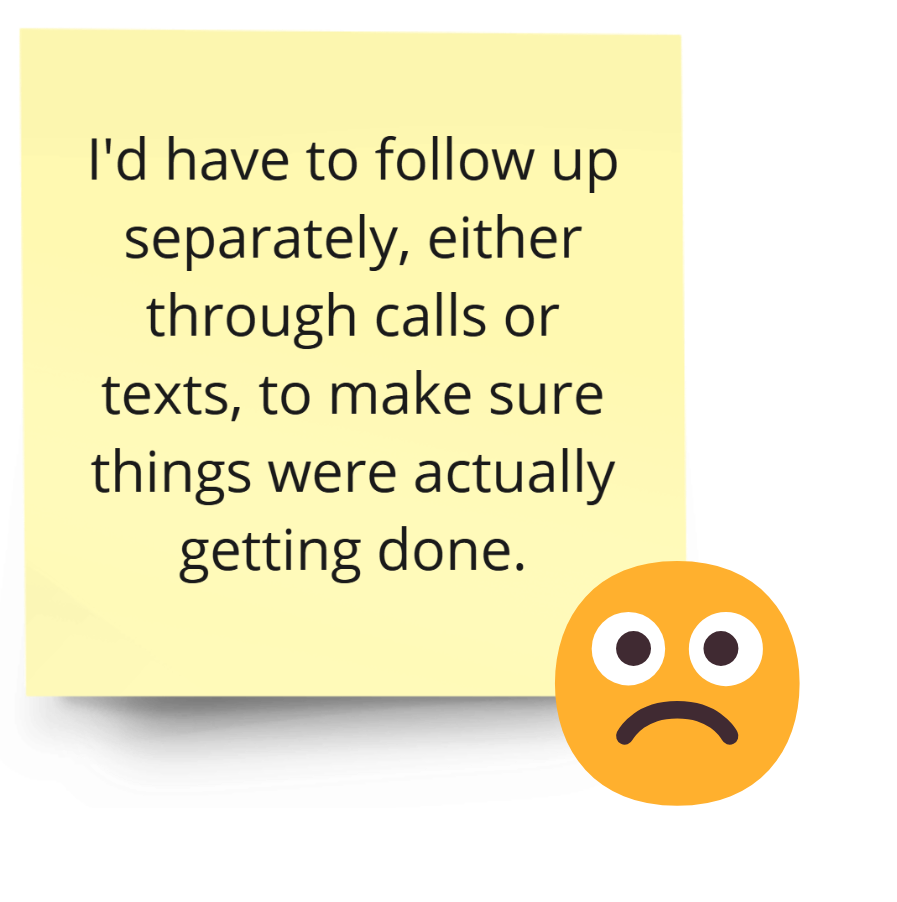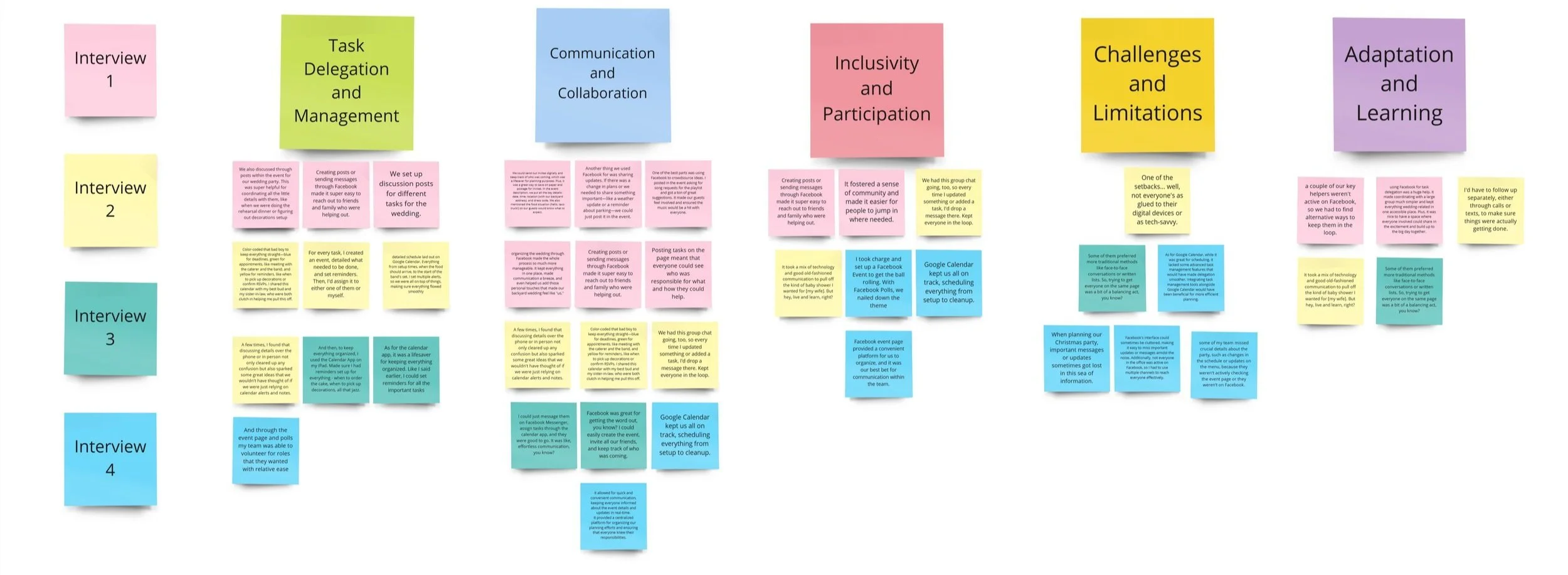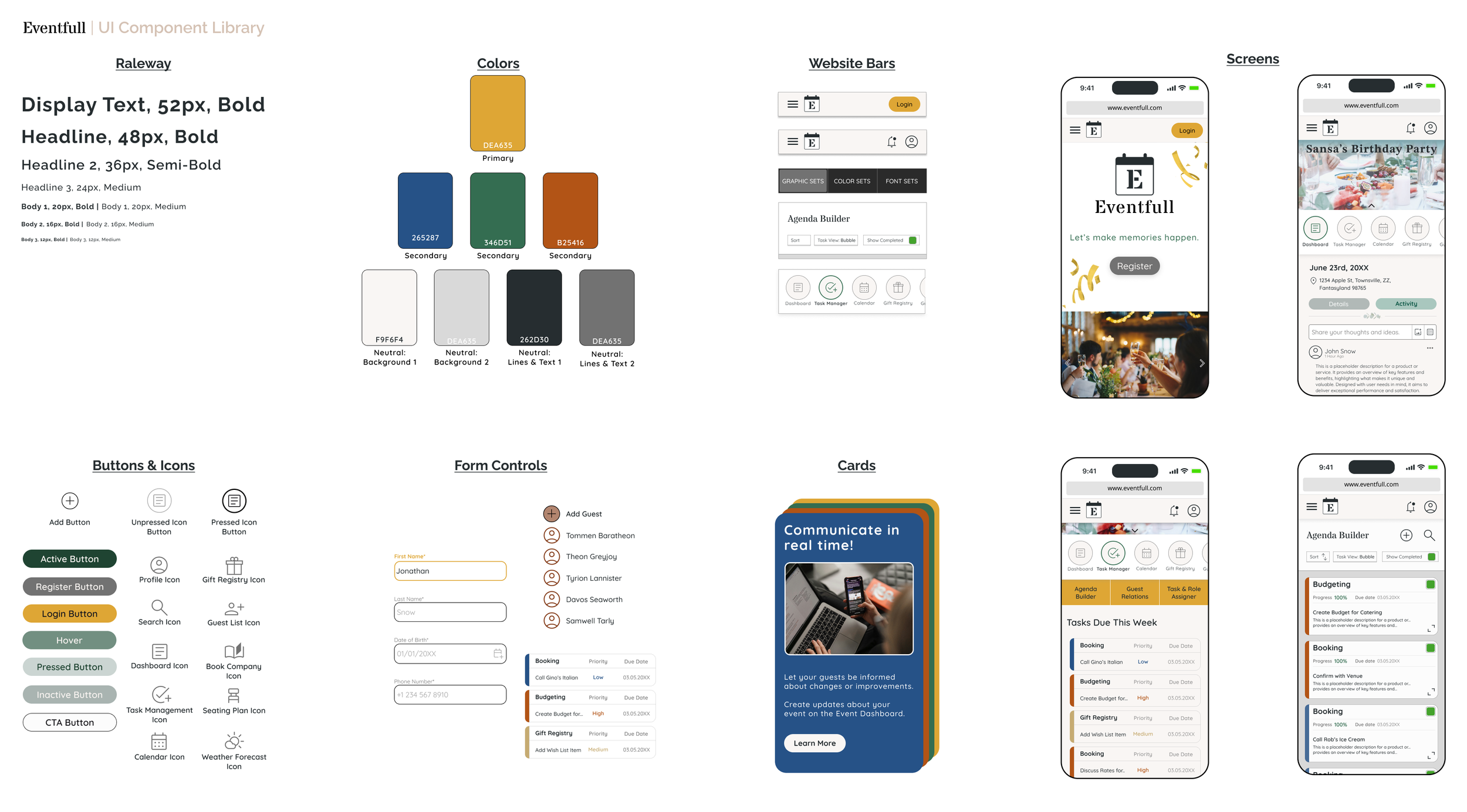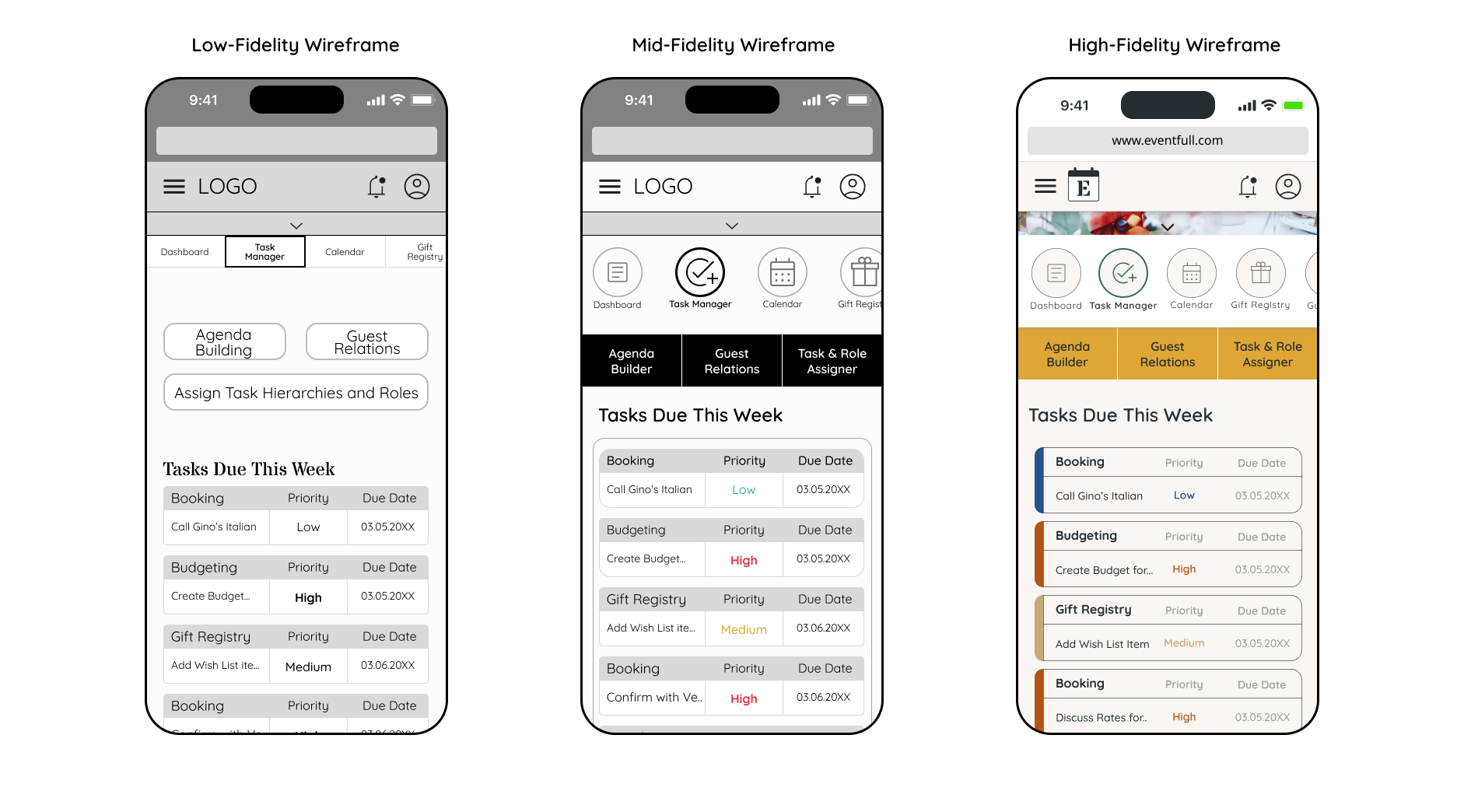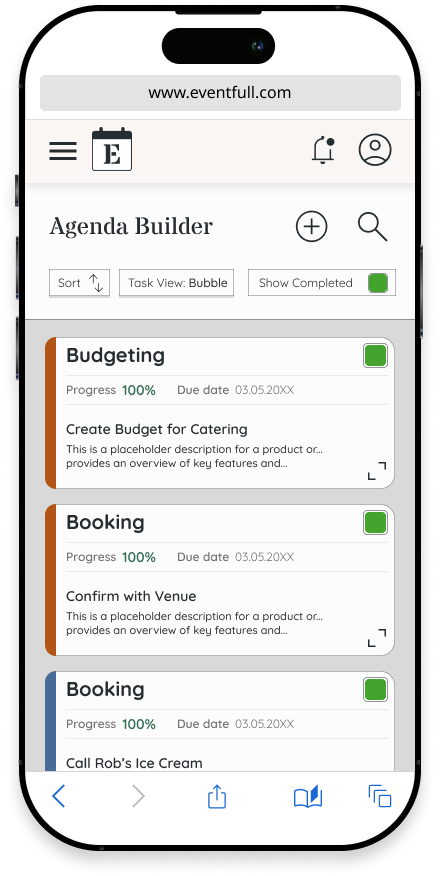Eventfull
Role
Sole UX/UI designer + brand designer, with support from my mentor, Ayelén Malaquin, and feedback from design critique facilitators and peers.
Problem
Based on user insights from digital platform interactions, a key challenge in non-professional event planning is the ineffective organization of task delegation and clear communication.
Tools
Figma, Miro, Google Meet, and Zoom
Solution
A website where a person can 1) customize themed templates associated with the event of interest, 2) readily update the guests by posting on the event dashboard in real-time, and 3) manage, delegate, and track the progression of tasks.

Introduction
User: Enable planner to express their creativity in event planning while centralizing communication.
The Users
Adults, ages 21-38, who have experiences with planning an event and have concerns with event task delegation and communication articulation across digital platforms.
The Product
Eventfull is an event management platform that helps users customize themed templates, keep guests informed with real-time updates on the event dashboard, and efficiently manage tasks through delegation and progress tracking.
The Goals
Business: Establish brand as the go-to solution for personalized event-planning for small-to-medium sized gatherings.
Technological: Simplify event planning features and communication to improve organization for planners.

Research
Methods
The solution came from blending insights across multiple research methods:
User Interviews
Affinity Mapping
Task Analysis
Competitive Analysis
Card Sorting
What I learned: Participants want digital tools that simplify planning, streamline communication, and make task management effortless. An intuitive platform reduces stress and keeps coordination smooth.
User Interviews
Four (4) remote and moderated interviews
Objectives:
By conducting these interviews, I aimed to:
people approach event planning
their motivations behind their choices
the pain points they encounter
their overall satisfaction with the digital solutions they utilize
Behavioral Needs
What I learned: Participants are driven by a desire to create memorable experiences that foster connection and celebration.
Effective organization and coordination are critical to ensuring a smooth event-planning process.
Pain Points
What I learned: Juggling multiple tools leads to information overload, missed updates, and lost engagement. Tracking tasks and accountability remains a major pain point.
Motivations
Gaining Insights
4. Challenges and Limitations
Participants experience frustration with cluttered interfaces and lost updates on Facebook, while Google Calendar lacks advanced delegation features. The need for a more streamlined, user-friendly event planning tool is evident.
Digital Needs
What I learned: Everyone relies on platforms like Facebook and Google Calendar, but they seek a single solution with task management, real-time updates, and easy delegation.
2. Task Delegation and Management
While platforms like Facebook Events allow for easy volunteer-based role assignments, some participants prefer more organized delegation methods. Google Calendar supports planning but lacks robust task management features, leading to inefficiencies in coordination.
3. Inclusivity and Participation
Digital tools help with volunteer participation. A mix of digital and traditional planning methods ensures broader accessibility and engagement.
5. Adaptation and Learning
Flexibility in adapting to different team preferences in digital spaces leads to smoother coordination and better event execution.
1. Communication and Collaboration
Digital platforms facilitate real-time updates and centralized communication, but engagement issues arise when not all participants actively use the same tool. Important details can be missed when notifications get buried, requiring multi-channel communication for full inclusion.

How might we improve communication between task assigners and assignees?
Mid-Fi wireframe of event page dashboard
Re-introducing the Familiar
User research suggests that learning a new social media platform can feel overwhelming.
To make the experience as intuitive as possible, how might we improve communication between task assigners and assignees for event planning?
Proposed Solution
Allow planners to create customizable event pages with task management capabilities and a social dashboard for centralized communication.

Designing the Solution
User Persona
My research shaped the User Persona, focusing on:
Building camaraderie through digital events and collaboration
Streamlining communication for clarity and efficiency
Tackling task fragmentation and priority confusion
How can my website improve communication between event planners, volunteers, and guests? How can it make task tracking easier? How can it merge social media, task management, and template personalization into one seamless platform?
User Flows
Optimizing Navigation: I learned how to design more intuitive navigation structures. By understanding how participants move through an application, I could streamline the paths to make them more efficient and user-friendly.
Enhancing Usability: Studying user flows helped me recognize the importance of clarity and simplicity in design. I discovered ways to reduce complexity and make interfaces more intuitive for participants.
Creating Consistent Experiences: Understanding user flows allowed me to ensure consistency across different parts of the application or website.
Brand Exploration
This mood board represents a warm, inviting, and user-friendly design for an event-creating website. It emphasizes collaboration through shared tools, transparency with clear navigation, and endearing aesthetics that create an approachable experience. Explorative elements encourage creative customization, while uniting visuals foster a sense of community and togetherness.
Designing the Website
Wireframe Progress

Usability Testing and Feedback
Usability Testing
The three testing objectives were:
1) Successfully register
2) Complete a navigation through template customization
3) Reach the task management page
What Went Wrong
Many participants found it confusing that the numbers indicating the registration page should be clickable.
There was concern about the absence of a confirmation pop-up after clicking “Launch” on the event creation screen.
All participants expressed concern about the lack of information regarding the "optionality" of payment methods. They felt uncertain about what to do if they chose to proceed without adding payment information.
What Went Right
All participants had no confusion with regards to where to navigate during the moderated task testing.
Participants appreciated the seamless transition from registration to the event dashboard.
Many expressed joy at the navigability of editing templates.
All participants expressed surprise at the thoughtfulness of task management capabilities.

Solution, Work-in-Progress
Event creation template selection
Feature Ideation
The event creation template selection feature lets planners choose a design from preset categories, with filters for color and graphics for easy customization.
The template edit allow planners to express their creativity to curate an event page that suits their needs. The event page let planners manage their events through a social media-like page for centralized communication and a feature carousel that allow for further event management such as calendar tracking and gift registry.
The task manager and agenda builder help planners organize and delegate tasks to the appropriate helpers and volunteers.
Task manager (left) and agenda builder (right)
Template edit (left) and event page (right)

The Next Steps
Develop the Rest of the Solutions
Since this was my first limited case study with Designlab, it felt like just the beginning of something bigger. Moving forward, I’m excited to apply what I’ve learned from iterative design and testing feedback to refine and expand Eventfull’s features.
My hope is to one day create a fully functional prototype — one that truly empowers people to turn their ideas into unforgettable memories.
What I Learned
The biggest lesson from this process is that clarity and efficiency are key in digital event planning tools. Planners need intuitive navigation, clear instructions, and seamless communication to feel confident using the platform.
By focusing on user-centered design, iterative testing, and data-driven improvements, we can create a smoother experience that meets both planner needs and business goals.
More Projects


